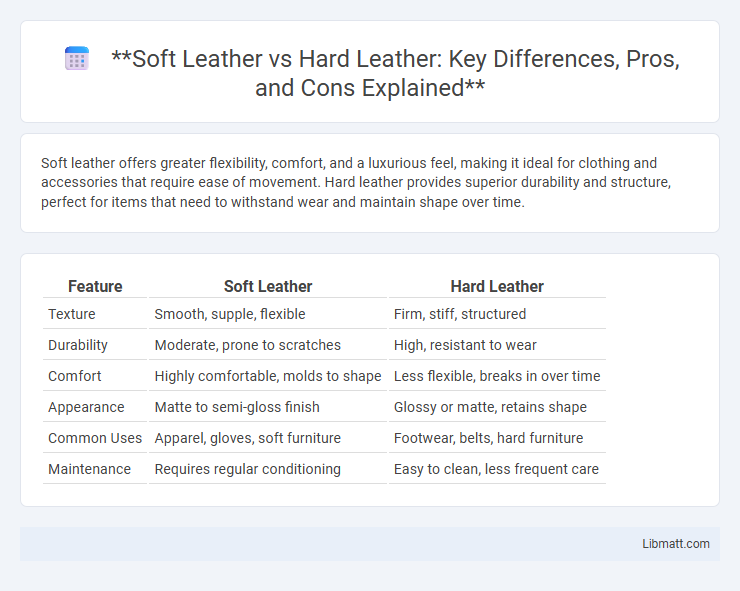Soft leather offers greater flexibility, comfort, and a luxurious feel, making it ideal for clothing and accessories that require ease of movement. Hard leather provides superior durability and structure, perfect for items that need to withstand wear and maintain shape over time.
Table of Comparison
| Feature | Soft Leather | Hard Leather |
|---|---|---|
| Texture | Smooth, supple, flexible | Firm, stiff, structured |
| Durability | Moderate, prone to scratches | High, resistant to wear |
| Comfort | Highly comfortable, molds to shape | Less flexible, breaks in over time |
| Appearance | Matte to semi-gloss finish | Glossy or matte, retains shape |
| Common Uses | Apparel, gloves, soft furniture | Footwear, belts, hard furniture |
| Maintenance | Requires regular conditioning | Easy to clean, less frequent care |
Introduction to Soft Leather vs Hard Leather
Soft leather offers flexibility, breathability, and a supple texture ideal for comfortable wear and delicate designs, while hard leather provides durability, structural support, and resistance to abrasion, suited for robust applications like boots and belts. The choice between soft and hard leather depends on your specific needs, such as comfort versus longevity or aesthetic appeal versus toughness. Understanding these distinct characteristics helps in selecting the best leather type for your project or product.
Defining Soft Leather: Key Features
Soft leather is characterized by its supple texture, lightweight feel, and enhanced flexibility, making it ideal for comfortable wear and delicate applications. It typically undergoes minimal tanning and finishing processes to preserve its natural softness, resulting in a smooth surface with a slight grain. Your choice of soft leather ensures superior breathability and a luxurious touch, perfect for garments and accessories that demand both style and comfort.
Defining Hard Leather: Key Features
Hard leather is characterized by its dense fiber structure, high durability, and firm texture that provides strong resistance to wear and tear. This type of leather typically undergoes minimal tanning and finishing processes, preserving its rigidity and making it ideal for protective gear, heavy-duty boots, and structured accessories. Understanding the key features of hard leather helps you select materials suited for long-lasting performance and robust applications.
Material Sources and Production Methods
Soft leather is typically derived from younger animal hides such as lamb or calf, processed using methods like chrome tanning to retain flexibility and suppleness. Hard leather commonly originates from older cattle hides and undergoes vegetable tanning or heavy oil treatments, resulting in a denser, more rigid material. Your choice between soft and hard leather affects durability, texture, and suitability for specific products based on these distinct material sources and production techniques.
Durability Comparison: Soft vs Hard Leather
Hard leather offers superior durability compared to soft leather due to its dense fiber structure and resistance to scratches and wear. Soft leather, while more flexible and comfortable, tends to show signs of aging and damage faster, including creases and scuffs. For applications requiring long-lasting strength, such as work boots or heavy-duty upholstery, hard leather is the preferred choice.
Comfort and Flexibility Differences
Soft leather offers superior comfort and flexibility due to its supple texture, allowing it to mold easily to the shape of the foot or body, making it ideal for prolonged wear. In contrast, hard leather provides greater durability and support but tends to be stiffer and less forgiving, which can result in longer break-in periods and reduced immediate comfort. The choice between soft and hard leather significantly impacts the level of comfort and range of movement, with soft leather preferred for flexibility and hard leather for structural stability.
Aesthetic Appeal and Texture
Soft leather boasts a supple, smooth texture that enhances the aesthetic appeal of luxury bags, shoes, and furniture by providing a rich, inviting look and feel. Hard leather offers a more structured, firm surface with a polished finish that maintains its shape over time and exudes a classic, durable elegance. Your choice between soft and hard leather impacts both the tactile experience and the visual sophistication of your leather goods.
Common Uses and Applications
Soft leather is widely used in fashion items such as gloves, jackets, and handbags due to its flexibility and comfort, making it ideal for products requiring a supple texture. Hard leather finds applications in durable goods like belts, shoes, saddles, and upholstery, where rigidity and abrasion resistance are essential for long-lasting performance. Both types are selected based on the balance of softness and toughness needed for specific uses in the apparel, automotive, and furniture industries.
Maintenance and Care Tips
Soft leather requires regular conditioning with a high-quality leather conditioner to maintain its suppleness and prevent cracking, while hard leather benefits from occasional polishing to preserve its rigidity and shine. Avoid exposing soft leather to excessive moisture, as it can cause staining and weaken the material, whereas hard leather should be cleaned with a damp cloth followed by drying to prevent mold. Your leather items will last longer when stored in a cool, dry place away from direct sunlight, regardless of the leather type.
Choosing the Right Leather for Your Needs
Soft leather offers flexibility, breathability, and enhanced comfort, making it ideal for garments or accessories requiring a supple feel. Hard leather provides superior durability, structure, and resistance to wear, perfect for protective gear or items needing long-lasting strength. Consider your specific use case and style preferences to choose the right leather for your needs.
Soft leather vs hard leather Infographic

 libmatt.com
libmatt.com